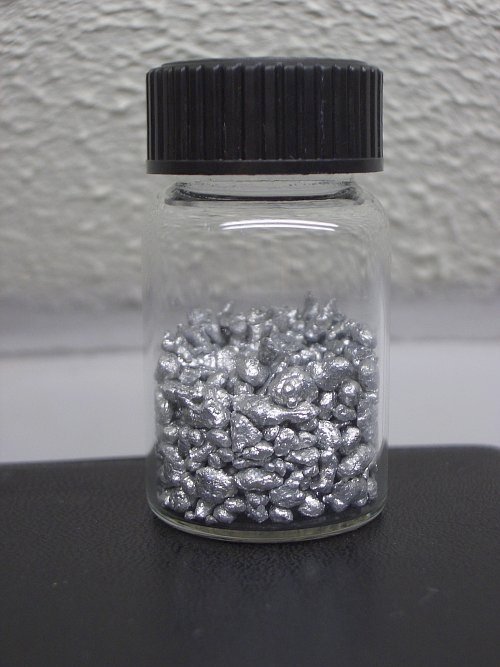


Antimony (stibium)
 Antimony is an element, which has many non-metallic
properties, but it looks like a metal. It is bluish grey with a metallic lustre.
Antimony is an element, which has many non-metallic
properties, but it looks like a metal. It is bluish grey with a metallic lustre.
The element is stable to air and moisture. It is not attacked by dilute acids at an appreciable rate. It dissolves readily in concentrated nitric acid, hot concentrated sulphuric acid and aqua regia. With concentrated nitric acid and aqua regia it is oxidized to the +5 oxidation state as hydrous Sb2O5 respectively SbCl5, with hot concentrated sulphuric acid it is oxidized to the +3 oxidation state as Sb3+ ions.
Elementary antimony can be obtained from eBay at very high purity. It is moderately priced and certainly is affordable for the home chemist, although it is not the first choice for an average home lab.
![]()
In its compounds, antimony is in the +3 oxidation state or the +5 oxidation state. In its +3 oxidation state, the element is amphoteric. Like true metals, it is capable of forming aqueous Sb3+ ions, but these ions are very easily hydrolysed. Solutions, containing antimony(III) ions must be strongly acidic, otherwise the ions are hydrolysed to hydrous antimony(III) oxide and a white precipitate is formed in the solutions. In its +5 oxidation state, the element has no basic properties anymore. Without a coordinating agent, the element forms hydrous Sb2O5, otherwise it may go in solution as neutral species or as anionic species.
For the home chemist, antimony sesquioxide, Sb2O3, is available as a white powder from ceramics and pottery suppliers. This compound readily dissolves in moderately to highly concentrated hydrochloric acid. It forms colorless aqueous Sb3+ ions, but also a colorless complex SbCl4–. For experimenting with antimony, the compound Sb2O3 is the most convenient, because it readily dissolves in hydrochloric acid.
Another moderately interesting compound is the dark grey antimony trisulfide, Sb2S3. This compound is primarily used in pyrotechnics, but it also is useful for some aqueous chemistry experiments. It dissolves in concentrated hydrochloric acid. When such solutions are diluted, then bright yellow hydrous antimony trisulfide precipitates again. This is a remarkable experiment.
A remarkable property of antimony(III) is that it can be kept in solution without hydrolysis at low acid strength by dissolving it in water, in which some tartaric acid is dissolved. Antimony(III) forms a stable complex with tartrate ion.
Antimony has fairly interesting redox chemistry and interesting coordination chemistry. For this reason, antimony sesquioxide is a nice addition to a home lab, but it is not one of the first compounds in an average home lab.

Antimony and its compounds are quite toxic. Be careful when performing experiments with antimony or its compounds. Especially the soluble compounds, obtained by dissolving antimony sesquioxide in acidic solutions must be handled with care.